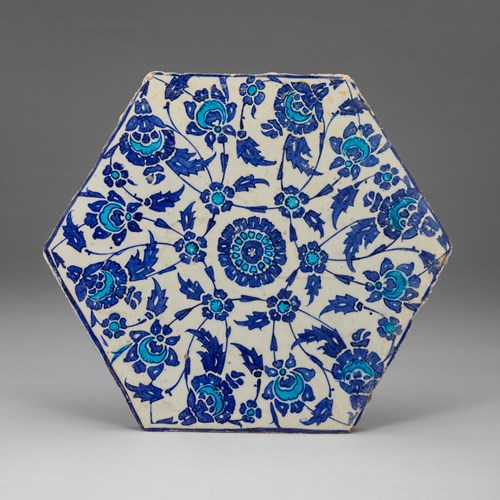Marketplace
Girl on a Street in Poonah
A young woman is painted in motion, adjusting her sari as she steps across the road. Amongst her Gujurati-style jewellery is a toe ring, which indicates that she is married. The eye is drawn by the red of the young woman’s sari. It is a colour strongly associated with celebration, prosperity, and good fortune due to its association with Lakshmi.1 In fact, on a couple’s wedding day, they are believed to become Lakshmi and Vishnu, making red the most popular colour for wedding saris.
In the background is a Jain temple, recognisable by its shikhar or sculpted domes, atop which are kalash, or golden pot finials. Though Green gave the location of the painting as ‘Poonah’, it is difficult to identify the location in the image. Not only has Pune City changed significantly in the past 175 years, becoming the largest city in Maharasthtra (even larger than Mumbai) thanks to its booming automobile and technology industries, but Pune District is also a vast administrative region encompassing many other cities and towns. Furthermore, the building may be Green’s invention, combining classical architectural elements to create an idealised temple. Whether or not the female subject was painted from a model or merely an idealised representation of an Indian woman is also to be questioned. Compared to his portraits of Western subjects, such as one formerly identified as the writer William Hazlitt, which now hangs in the Guildhall Art Gallery, London (see accession no. 848), the woman is much less detailed and characterful. Green may have drawn inspiration for the subject matter from the work of British artist Tilly Kettle (1735-1786), whose famous Dancing Girl portrait, now housed in the Yale Center for British Art, New Haven (accession no. B1981.25.385), depicts a young woman posed, dressed, and accessorised very similarly to the woman in the present painting.
Edward Frederick Green was born in London in 1801. He was admitted to the Royal Academy as a student from April 1822. In 1845, tragedy struck. Green’s wife, Catherine Colona Stilton, died in London from consumption (tuberculosis). Three weeks after her death, Green sold all of his paintings at auction and moved to India. The architecture and landscape of India was a major attraction for artists. However, it was portraits which proved to be the more lucrative subject.2 Not only did artists paint posed portraits of local dignitaries, but also ordinary citizens of India engaged in daily life. Green’s address is recorded as Bombay, however, his paintings from this time are signed with ‘Poonah’. Given that the city of Pune was under the administration of the Bombay Municipality since falling to the British in 1817, it is possible that Green was a resident there. During his time in India, Green also painted two portraits of snake charmers, one of which was exhibited at the Royal Academy in 1851. A painting of six Indian girls at a well, possibly in Pune, is also attributed to Edward Frederick Green.3
[1] Lochtefeld, James G. The Illustrated Encyclopedia of Hinduism, Vol. 1. New York: The Rosen Publishing Group, 2002. Pp. 385-386.
[2] McAleer, John. Picturing India: People, Places, and the World of the East India Company. London: British Library, 2017. p. 133.
[3] See Amir Mohtashemi catalogue, Indian and Islamic Works of Art, March 2014. Cat. 22.
Plus d'œuvres d'art de la Galerie









